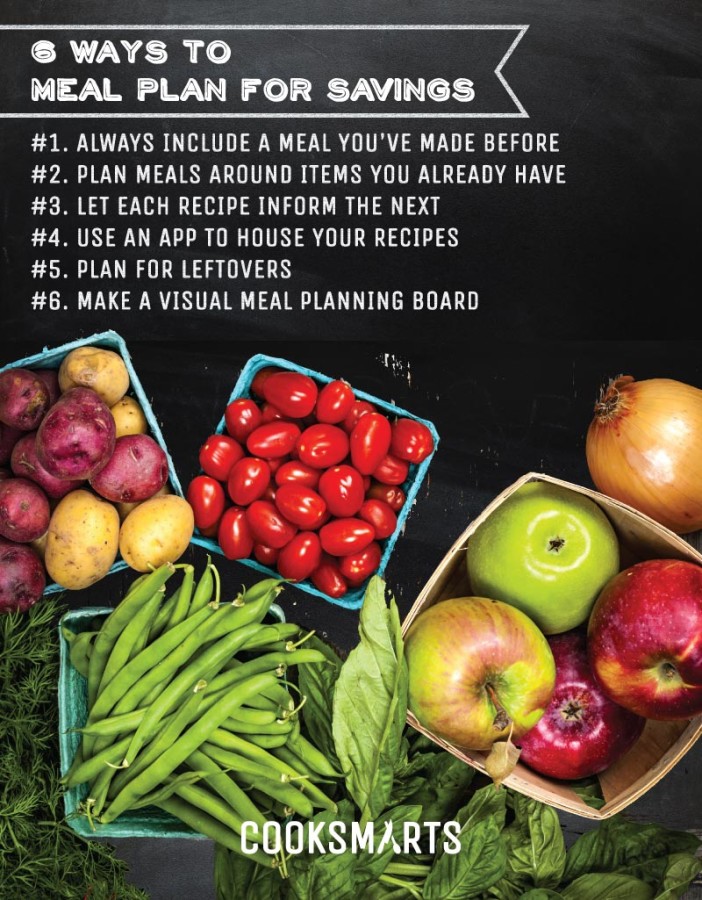Cooking on a Budget Part 1: Planning for Savings

How to Meal Plan for Maximum Savings and 3 Kinds of Meal Planning Services
With holiday spending right around the corner, I thought October would be a good month to talk “Cooking on a Budget” and highlight all the ways you can save money in the kitchen. This will be a three-part series, split up by the three stages of cooking:
- Planning
- Grocery shopping
- Cooking
Today, we’ll kick off with planning, which really lays the groundwork for savings. If you plan well, you’re likely to spend less grocery shopping; I recently read that when you go to the store without a list, you can spend up to 40% more! Plus, you’re of course more likely to actually cook with a plan in place.
A plan can take on any form. At the most basic, it’s a simple grocery list, but you’ll save even more when there is a meal plan behind that list.
For those who want to meal plan on their own, here are my 6 tips for how to meal plan for maximum savings:
- Always include at least one meal you’ve made before: Don’t try to reinvent the wheel every time you cook. Every home cook needs a few back-pocket recipes that they can cook well and know will be gobbled up by the whole family vs. pushed aside after a few bites. The more standbys you use, the less likely you’ll have to acquire new pantry ingredients, which can definitely add up.
- Plan meals around items you already have: Before making your plan, go through your pantry, fridge, and freezer and make a “To-Use” list. Start by building your recipes around those items so you have less to buy at the grocery store.
- Let each recipe inform the next: Good meal planning is like putting together a puzzle. Try to avoid selecting different recipes that don’t fit together or else you’ll be buying a lot of different ingredients. Select one, look at the ingredient list and let that help you select recipe #2, and so on. For example, if recipe #1 uses half a head of cabbage, I might find another recipe that needed cabbage, so that it wouldn’t be wasted. Or if I was going to make rice for recipe #1, then I would try to find a recipe that used leftover rice for recipe #2, so that I could make once and eat two different ways. If you need help finding recipes with specific ingredients, sites like Yummly or Foodily can be very helpful.
- Use an app to house all your recipes: It would be very time consuming and painful to search through cookbooks, food sites, Pinterest boards etc. to make a meal plan every week. What you want is a way to house all your recipes in one place; luckily there is an app for that! Options like Pepperplate, Paprika, and ZipList can save all your recipes (you can copy and paste or there is a bookmarklet that you install on your browser). You make your meal plan from those recipes, and they generate a grocery list for you for FREE!
- Plan for leftovers: I never really understood cooking just the exact amount for one meal. Planning on leftovers and being able to take last night’s dinner for lunch is a huge savings. Beyond that make extra for freezing, so that there is always a back-up meal in stock.
- Make it visual: A mentor once told me if you physically write down your goals, you are more likely to complete them. I’ve adopted this philosophy for meal planning. Making your meal plan visual may hold you more accountable for executing on the cooking. Plus, your family isn’t constantly asking you, “What’s for dinner?” They can just refer to the board. Here are some great ideas on Pinterest for visual meal planning boards.
Good meal planning can take time, and it’s definitely one stage you can outsource for a few dollars a month. Even though you’re paying for meal plans, you’ll save much more than you paid with savings from less food wasted and last-minute take-out or eating out. Here are 3 different kinds of paid meal planning services out there:
- Customized around diet: This is the category our service falls under. You subscribe and every week, you get a new menu sent to you that features a diverse rotation of healthy and simple meals. You choose the diet options you want.
- Customized around sales: Food on the Table has a really interesting product that plans a menu based on the grocery stores you shop at and picks recipes to align with their sales. If you shop at any of the big chain stores, this is a great option.
- Customized around a CSA: If you belong to a CSA (community supported agriculture) service and are always struggling to use everything up in your produce box, check out Design My Meals. They’ve connected with several CSA’s and come up with menus based on what you’ll receive for the week.
Whether you choose to outsource or give it a go on your own, if you prioritize planning, you’ll definitely see your grocery bill go down and the amount of food you toss decrease (those are real dollars being thrown away!). If you have a story on how meal planning has saved you money, share it below in the comments! Get our meal planning toolkit
